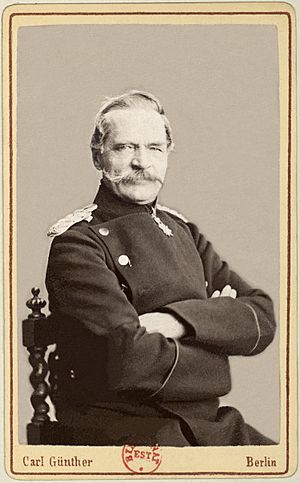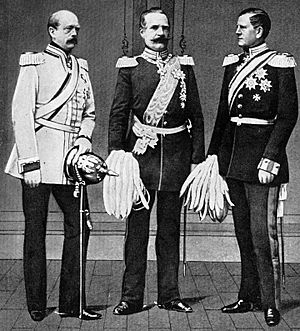Albrecht von Roon facts for kids
Quick facts for kids
Albrecht Graf von Roon
|
|
|---|---|

Albrecht von Roon in the 1870s
|
|
| Born | 30 April 1803 Pleushagen, Prussia, Holy Roman Empire (present-day Pleśna, West Pomeranian Voivodeship, Poland) |
| Died | 23 February 1879 (aged 75) Berlin, Province of Brandenburg, Kingdom of Prussia, German Empire |
| Buried |
Reichenbach
|
| Allegiance | |
| Service/ |
Prussian Army |
| Years of service | 1821–1873 |
| Rank | Generalfeldmarschall |
| Battles/wars |
|
| Awards |
|
Albrecht Theodor Emil Graf von Roon (born April 30, 1803 – died February 23, 1879) was an important soldier and politician from Prussia. He served as the Minister of War from 1859 to 1873. During the 1860s, Roon, along with Otto von Bismarck and Helmuth von Moltke, was one of the most powerful figures in Prussia's government.
This was a key time when Prussia won several wars against Denmark, Austria, and France. These victories led to the different German states joining together to form one country, Germany, under Prussia's leadership. Roon believed in a strong government led by a king. He worked hard to make the Prussian army better and more effective.
Contents
Early Life and Military School
Roon was born in Pleushagen, which is now Pleśna in Poland. His family originally came from Flanders (part of modern-day Belgium and the Netherlands) before settling in Pomerania. His father was an officer in the Prussian army. Sadly, his father died poor during the Napoleonic Wars, when French armies occupied Prussia. Young Roon was then raised by his grandmother.
In 1816, Roon joined a military school for young students in Kulm (now Chełmno, Poland). He then moved to the military school in Berlin in 1818. In January 1821, he became an officer in the 14th regiment. In 1824, he took an advanced three-year course at the General War School in Berlin. This helped him improve his general knowledge and military skills. Two years later, he was moved to the 15th regiment.
Starting His Military Career
In 1832, Roon returned to his regiment. He was then assigned to the headquarters of General von Müffling's observation corps. Here, he noticed that the Prussian Army was not very efficient. In 1833, he was appointed to the Topographical Bureau in Berlin, which dealt with maps and land surveys.
By 1835, he joined the Prussian General Staff, which was the army's main planning group. He was promoted to captain and became a teacher and examiner at the military academy in Berlin. In 1842, after being sick for two years from overwork, he was promoted to major. He was assigned to the staff of the VII Corps. Again, he saw how disorganized the army was. He started thinking about ways to make it better.
In 1844, Roon became a tutor to Prince Friedrich Karl. He traveled with the prince to Bonn University and during his trips around Europe. In 1848, he became the chief of staff for the VIII Corps. During the unrest that year, he helped Prince William (who later became king and emperor) stop an uprising in Baden. Roon showed great energy and bravery. He received an award for his service. While working with Prince William, he talked to him about his ideas for army reform. In 1850, after problems with army organization became clear, Roon was made a lieutenant-colonel. In 1851, he became a full colonel.
Reforming the Army
Roon was promoted to major-general in 1856 and to lieutenant-general in 1859. He had held several important positions since 1850. In 1858, Prince Wilhelm became the regent (a ruler who governs for a king who is too young or ill). In 1859, Prince Wilhelm asked Roon to join a group that would suggest ways to reorganize the army. During the Austro-Sardinian War, Roon was in charge of getting a division of soldiers ready. At the end of 1859, he became the War Minister, even though he was a junior general. In 1861, he was also put in charge of the navy.
Roon, with help from Edwin von Manteuffel and the new Prussian Chief of Staff, Helmuth von Moltke, created plans to update the army. The old system, designed by Gerhard von Scharnhorst, called for three years of military service for everyone. It also suggested raising new regiments and reducing the role of the reserve army, called the Landwehr. The Landwehr was famous for its role in the War of Liberation in 1813.
However, Roon believed the Landwehr was not effective enough for modern warfare. He also thought it caused political problems. Roon's ideas for reorganizing the army faced strong opposition from the Prussian Landtag (the Prussian parliament). The parliament was controlled by the liberal German Progress Party, which wanted to control the army's budget. It took years of political struggle and strong support from the new prime minister, Otto von Bismarck, and Moltke, before Roon's plans were finally accepted.

A National Hero
After Prussia won the Second Schleswig War in 1864, Roon became a national hero in Germany. Before this, many people in Prussia disliked him.
When the Austro-Prussian War began, Roon was promoted to General der Infanterie. He was present at the important victory at Königgrätz, where Moltke was in command. Roon received the Order of the Black Eagle award. After 1866, his army system was adopted by the entire North German Confederation. In later years, other countries in Europe copied his army system.
During the Franco-Prussian War in 1870–71, Roon was with Prussian King Wilhelm I. This war was a huge victory for Prussia, and Roon's work greatly helped this success. He was given the title of Graf (count) on January 19, 1871, shortly after Moltke. In January 1873, he took over from Bismarck as Minister President of Prussia. However, he had to resign later that year due to poor health, giving the job back to Bismarck. Roon was promoted to field marshal on January 1, 1873.
Albrecht von Roon died in Berlin on February 23, 1879. He was buried in his family's crypt at Schloss Krobnitz.
Memorials
The armored cruiser SMS Roon, a type of warship completed in 1906, was named after Albrecht von Roon.
Honours
He received many awards and decorations, including:
 Prussia:
Prussia:
- Pour le Mérite (military), October 28, 1870
- Knight of the Black Eagle, with Collar, November 9, 1873
- Grand Cross of the Red Eagle, with Swords and Oak Leaves
- Knight of the Prussian Crown, 1st Class with Swords
- Grand Commander's Star of the Royal House Order of Hohenzollern
- Iron Cross (1870), 1st and 2nd Class
- Service Award Cross
- Knight of Justice of the Johanniter Order
 Saxony:
Saxony:
- Grand Cross of the Albert Order, 1860
- Knight of the Rue Crown, 1870


 Ernestine duchies: Grand Cross of the Saxe-Ernestine House Order, August 1860
Ernestine duchies: Grand Cross of the Saxe-Ernestine House Order, August 1860 Belgium: Grand Cordon of the Order of Leopold
Belgium: Grand Cordon of the Order of Leopold Brunswick: Grand Cross of Henry the Lion
Brunswick: Grand Cross of Henry the Lion Hanover: Grand Cross of the Royal Guelphic Order, 1860
Hanover: Grand Cross of the Royal Guelphic Order, 1860 Hesse-Darmstadt:
Hesse-Darmstadt:
- Grand Cross of Philip the Magnanimous, December 4, 1860
- Grand Cross of the Ludwig Order, January 9, 1871
- Military Merit Cross, March 16, 1871
 Austria:
Austria:
- Grand Cross of the Imperial Order of Leopold, 1861
- Grand Cross of St. Stephen, 1872
 Bavaria:
Bavaria:
- Grand Cross of Merit of the Bavarian Crown, 1861
- Grand Cross of the Military Merit Order
 Mecklenburg:
Mecklenburg:
- Grand Cross of the Wendish Crown, with Swords
- Military Merit Cross, 2nd Class (Schwerin)
- Cross for Distinction in War (Strelitz)
 Saxe-Weimar-Eisenach: Grand Cross of the White Falcon, May 6, 1861
Saxe-Weimar-Eisenach: Grand Cross of the White Falcon, May 6, 1861 Hesse-Kassel: Grand Cross of the Wilhelmsorden, May 15, 1861
Hesse-Kassel: Grand Cross of the Wilhelmsorden, May 15, 1861 Nassau: Grand Cross of Adolphe of Nassau, with Swords, July 1861
Nassau: Grand Cross of Adolphe of Nassau, with Swords, July 1861 Russia:
Russia:
- Knight of St. Alexander Nevsky, in Diamonds
- Knight of St. George, 3rd Class
- Knight of St. Vladimir, 1st Class with Swords
 Schaumburg-Lippe: Military Merit Medal
Schaumburg-Lippe: Military Merit Medal Ascanian duchies: Grand Cross of Albert the Bear, December 20, 1862
Ascanian duchies: Grand Cross of Albert the Bear, December 20, 1862 France: Grand Cross of the Legion of Honour, September 9, 1864
France: Grand Cross of the Legion of Honour, September 9, 1864 Baden:
Baden:
- Grand Cross of the Military Karl-Friedrich Merit Order, 1867
- Knight of the House Order of Fidelity, 1871
 Württemberg:
Württemberg:
- Grand Cross of the Württemberg Crown, 1868
- Grand Cross of the Military Merit Order, December 30, 1870
 Oldenburg: Grand Cross of the Order of Duke Peter Friedrich Ludwig, with Golden Crown and Collar, June 16, 1869
Oldenburg: Grand Cross of the Order of Duke Peter Friedrich Ludwig, with Golden Crown and Collar, June 16, 1869
See also
 In Spanish: Albrecht von Roon para niños
In Spanish: Albrecht von Roon para niños

